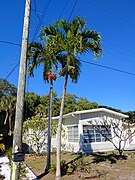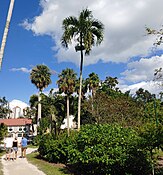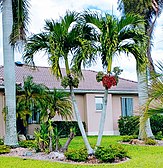Adonidia merrillii
| Adonidia merrillii | |
|---|---|

| |
| Scientific classification | |
| Kingdom: | Plantae |
| Clade: | Tracheophytes |
| Clade: | Angiosperms |
| Clade: | Monocots |
| Clade: | Commelinids |
| Order: | Arecales |
| Family: | Arecaceae |
| Genus: | Adonidia |
| Species: | A. merrillii
|
| Binomial name | |
| Adonidia merrillii | |
| Synonyms[3] | |
| |
Adonidia merrillii, the Manila palm, is a palm tree species native to the Philippines (Palawan and Danjugan Island).[1] This palm was cultivated for centuries in East Asia before becoming a staple in the West. It is reportedly naturalized in the West Indies and Florida.[3] It is commonly known as the "Christmas palm" because its fruits become bright scarlet and tend to be that color in winter. This palm is typically fairly small and slender, normally attaining 25 feet[4] or 8 meters[5] in height but has attained over 40 feet in some instances.[citation needed] Most plants maintain 5-7 fronds when young, gradually building up the crown as the palm ages, and sometimes reaches 10-12 fronds when mature.
Uses, cultivation, and care
[edit]This section needs additional citations for verification. (October 2024) |
The Adonidia palm, sometimes described as the "mini-royal-palm", adapts well to landscaping and cultivation, as well as growing in pots. It is able to withstand large amounts of rainfall and can tolerate short droughts, though it does not like sea salt. Adonidias prefer full sun but can withstand partial shade. They are not tolerant of the cold, making their perennial outdoor usage limited to frost-free zones. One of the most common landscape palms in Southern Florida (used at such places as the Miami Open tennis tournament), it is often clustered together in groups of 2-3, sometimes four. Because, in its natural state, it grows as a solitary palm, this batching together of several heads runs the risk of the head competing against themselves. In order to minimize the risk, nurseries train these palms when young to arch outward, instead of growing straight up.
Adonidia merrillii is widely planted in cultivation and grows well in tropical locations such as Hawaii and the southern half of the Florida peninsula. It is also one of the most commonly planted ornamental palms in the world, often planted in non-tropical locations such as shopping malls.[citation needed] It is sometimes used as an annual in places that freeze in the Winter (for example, Times Square, New York City plants these for the warm-weather season).
The Adonidia is also commonly placed indoors in hotels, casinos, and other higher-end establishments due to its ability to adjust to lower light conditions. They are self-pruning palms and require little to no maintenance.[4] Its fruits are sometimes said to be used as a substitute for the betel nut, in preparing buyo (fruit of Areca catechu, leaves of Piper betle, and lime) for chewing.[5]
Gallery
[edit]References
[edit]- ^ a b Energy Development Corporation; et al. (EDC) (2020). "Adonidia merrillii". IUCN Red List of Threatened Species. 2020: e.T38747A67530097. doi:10.2305/IUCN.UK.2020-3.RLTS.T38747A67530097.en. Retrieved 17 November 2021.
- ^ Beccari, Odoardo. Philippine Journal of Science 14:329. 1919.
- ^ a b "World Checklist of Selected Plant Families: Royal Botanic Gardens, Kew". wcsp.science.kew.org. Retrieved 23 December 2020.
- ^ a b "Christmas Palm - Gardening Solutions - University of Florida, Institute of Food and Agricultural Sciences". gardeningsolutions.ifas.ufl.edu. Retrieved 23 December 2020.
- ^ a b Brown, William H.; Merrill, Elmer D. (1919). Philippine Palms and Palm Products. Philippine Islands Bureau of Forestry. pp. 15–16.









